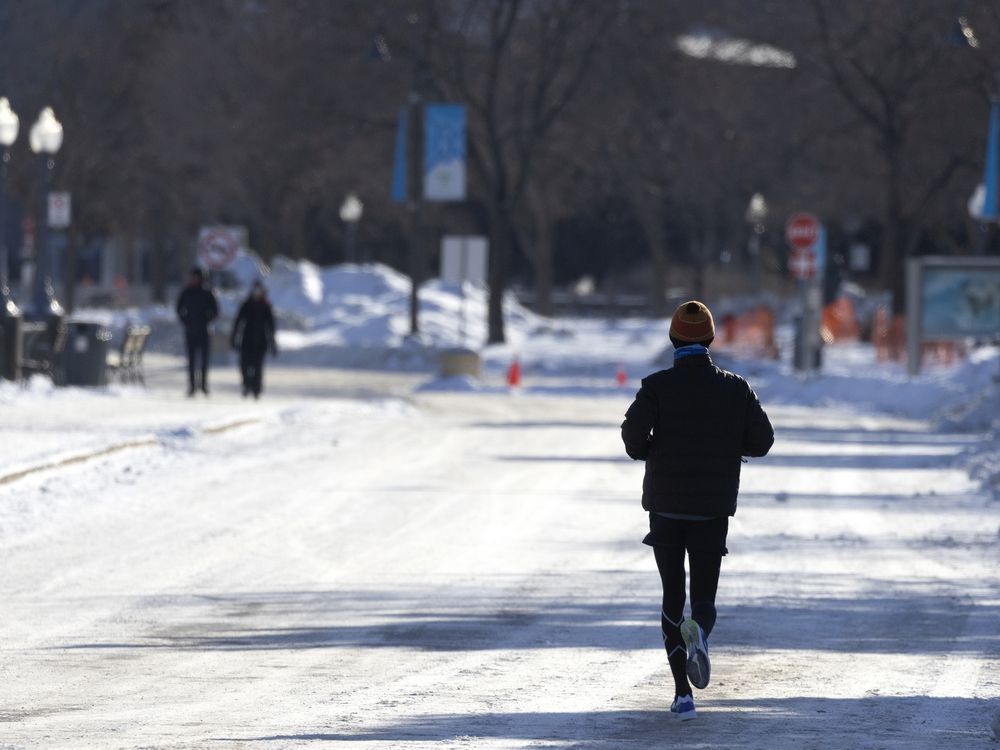A playlist with a bit more pep can help increase your cadence and decrease your risk of injury.
Postmedia may earn an affiliate commission from purchases made through our links on this page.
Article content
There are lots of reasons to listen to music while running. Your favourite playlist dulls the discomfort associated with effort, making a tough run feel easier while boosting mood. But more than just being a welcome distraction, there’s something about the beat of your favourite pump-up song that makes your feet move a little faster.
Advertisement
This advertisement has not loaded yet, but your article continues below.
Article content
It’s that intuitive response to tempo that inspired a team of researchers from the Netherlands to consider how running to music could reduce the risk of injury. Their idea was to let music direct an increase in running cadence — the number of strides per minute. A shorter stride and quicker turnover keeps the landing foot under your centre of mass, reducing impact stress on the lower body while improving efficiency by easing up on the breaking forces of every footfall.
But modifying your stride isn’t easy, especially as fatigue sets in. Most runners have settled into a preferred cadence, so change takes concentration and lots of inner cues to make sure old habits don’t slowly creep back into deep-rooted mechanics.
Advertisement
This advertisement has not loaded yet, but your article continues below.
Article content
That’s where music can help. It’s already been established that music can motivate runners to pick up the pace, so it’s not a big stretch to suggest it can speed up cadence as well. (The two don’t always go hand in hand.) But the important question is: Will that quicker turnover last, or will it slowly fade without music as a guide?
To find out more about the influence of music on running stride, the researchers gathered a small sample of seasoned recreational runners for a 12-week intervention. The first few weeks were all about establishing a baseline cadence, followed by four weeks of running with music selected to realize a 7.5 to 10 per cent higher stride rate. The last three to five weeks consisted of post-intervention workouts that evaluated whether cadence remained elevated or returned to baseline without music.
Advertisement
This advertisement has not loaded yet, but your article continues below.
Article content
All of the runs were five to 10 kilometres along a route with as few hills, traffic lights and crossings as possible, with the music chosen by the research team based on a strong, easy-to-follow rhythm at the desired tempo. No consideration was given to musical genre or artist. Runners ran the route twice a week and were asked to adjust their cadence “to the rhythm of the music.” Using a smartwatch, the average cadence, speed, heart rate, distance and altitude were calculated and downloaded after every workout to see, among other things, if a change of cadence also resulted in a change of intensity. A total of 24 runs were accumulated over the course of the study.
At the end of the four-week intervention period, the runners had increased their cadence by an average of 8.5 per cent, with no accompanying increase in speed or heart rate. Three to five weeks after the music intervention ended, cadence dropped, but only slightly, with the average turnover still 7.9 per cent higher than baseline.
Advertisement
This advertisement has not loaded yet, but your article continues below.
Article content
“The individual responses of the participants were very consistent as all participants increased the cadence immediately after the start of the music intervention,” said the researchers. “We also found that all participants enjoyed running with music, and running with the increased cadence at the end of the post-intervention phase was experienced as easier and more pleasant compared to running during the baseline phase.”
The ability to cause a change in cadence so quickly, and with something as easy and pleasant as syncing turnover to the rhythm of music, leads to hope for runners who want to ease stress on their knees and hips while improving the efficiency of their stride. The fact that running economy — the ability to run further or faster with less effort — also improves with a quicker turnover is a bonus. And since most of us already run with music, it simply means choosing a playlist with a bit more pep than we’re used to.
Advertisement
This advertisement has not loaded yet, but your article continues below.
Article content
To find your cadence, simply count the number of times your right or left foot hits the ground in 60 seconds during a regularly paced run, and double it. If you use a running app, it probably already records your cadence as part of your post-run stats.
Most recreational runners should strive for a cadence between 160 and 180. Proceed with caution, however: as with any change to your running routine, boost your cadence in gradual increments. Don’t start running to Footloose (174 beats per minute). Instead, try the Knack’s My Sharona (150 bpm), Queen’s Crazy Little Thing Called Love (155 bpm) or Taylor Swift’s Shake It Off (160 bpm).
There are plenty of curated playlists based on beats per minute, so search your favourite streaming service for an appropriate one and use the music to get a feel for a shorter stride. Not only will your knees thank you, you’ll find a whole new appreciation for what music can add to your run.
-

Fitness: It’s time to get kids moving again
-

Fitness: Gym closings can affect the mind as much as the body
-

Fitness: How tough was your last workout?








